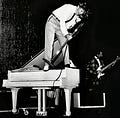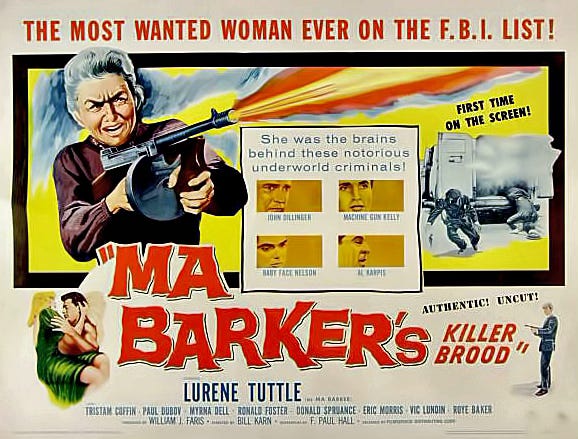Jerry Lee Lewis, bible school dropout, recorded "Great Balls of Fire" at Sun Records 66 years ago today
Jerry Lee Lewis was not the only early rock-and-roller from a strict Christian background who struggled to reconcile his religious beliefs with the moral implications of the music he created.
He may have been the only one to have one of his religious crises caught on tape — in between takes on one of his legendary hit songs.
It was on October 8, 1957 — 66 years ago today — that bible-school dropout Jerry Lee Lewis laid down the definitive version of "Great Balls Of Fire," amidst a losing battle with his conscience and with the legendary Sam Phillips, head of Sun Records.
Jerry Lee Lewis had first made his way to Sun Records in September, 1956, hoping to catch his big break in the same Memphis recording studio where Elvis had caught his.
The result of Lewis' first session, in November, 1956, was the minor hit, "Crazy Arms," but six months later, he and Phillips struck gold with "Whole Lotta Shakin' Goin On," a million-selling smash.
Lewis's signature piano-pounding style and electric stage presence made him an instantaneous star, but stardom didn't quiet the doubts that his upbringing in the Assemblies of God church had given him about rock and roll. Those doubts would be on open display when he went back to the studio on this day in 1957.
It was hours into the "Great Balls Of Fire" session when Jerry Lee began arguing with Sam Phillips that the song was too sinful for him to record. As the two talked loudly over each other, Phillips pleaded with Lewis to believe that his music could actually be a force for moral good.
Phillips: "You can save souls!"
Lewis: "No, no, no, no!"
Phillips: "YES!"
Lewis: "How can the devil save souls? I got the devil in me!
Jerry Lee somehow made peace with the conflict over the course of the next hour, becoming comfortable enough to begin making various unprintable statements on his way to saying with enthusiasm, "You ready to cut it? You ready to go?" just before launching into the take that would soon become his second smash-hit single.
Jerry Lee Lewis' moral struggles would continue throughout a storied career that would never quite recover from the 1958 disclosure of his marriage to a 13-year-old cousin.
At the peak of his powers following "Great Balls Of Fire," however, he was a figure as magnetic as any in rock-and-roll history.
As the producer, Don Dixon, would later say in an NPR interview, "Little Richard was fun, Elvis was cool but Jerry Lee Lewis was frightening."
Here, Lewis performs “Great Balls of Fire”
Thanks History.com
Chevy Chase plays piano at a loft party benefit for the Jazz Foundation of America, New York City
Photo by Frank Beacham
Chevy Chase is 80 years old today.
A comedian, writer, and television/ film actor, Chase was born into a prominent New York family and worked odd jobs before moving into comedy acting with National Lampoon.
He quickly became a key cast member in the inaugural season of Saturday Night Live, where his Weekend Update skit soon became a staple of the show.
Chase is also well known for his portrayal of the character, Clark Griswold, in four National Lampoon's Vacation films, and for his roles in other successful comedies such as Caddyshack (1980), Fletch (1985) and Three Amigos! (1986).
He has hosted the Academy Awards twice (1987 and 1988) and briefly had his own late-night talk show, The Chevy Chase Show.
In 2009, he began appearing as Pierce Hawthorne on the NBC comedy series, Community.
Chase played drums with the college band, The Leather Canary, headed by school friends, Walter Becker and Donald Fagen. Chase has called the group "a bad jazz band." Becker and Fagen later found their chops and founded the successful group, Steely Dan.
Chase has absolute pitch. He played drums and keyboards for a rock band, Chamaeleon Church, which recorded one album for MGM Records before disbanding in 1969.
Here, Chase does a classic scene from the film, “Christmas Vacation” in 1989.
Harvey Pekar was born 84 years ago.
Pekar was an underground comic book writer, music critic and media personality, best known for his autobiographical American Splendor comic series. In 2003, the series inspired a well-received film adaptation of the same name.
Frequently described as the poet laureate of Cleveland, Pekar helped change the appreciation for and perceptions of the graphic novel, the drawn memoir and the autobiographical comic narrative.
Pekar described his work as "autobiography written as it's happening. The theme is about staying alive, getting a job, finding a mate, having a place to live, finding a creative outlet. Life is a war of attrition. You have to stay active on all fronts. It's one thing after another. I've tried to control a chaotic universe. And it's a losing battle. But I can't let go. I've tried, but I can't."
Pekar and his younger brother, Allen, were born in Cleveland, Ohio to Saul and Dora Pekar, immigrants from Białystok, Poland. Saul Pekar was a Talmudic scholar who owned a grocery store on Kinsman Avenue, with the family living above the store.
While Pekar said he wasn't close to his parents due to their dissimilar backgrounds and because they worked all the time, he still "marveled at how devoted they were to each other. They had so much love and admiration for one another."
As a child, Pekar's first language was Yiddish, and he learned to read and appreciate novels in the language. Pekar has said that for the first few years of his life, he didn't have friends. The neighborhood he lived in had once been all white but became mostly black by the 1940s; as one of the only white kids still living there Pekar was often beaten up.
He later believed this instilled in him "a profound sense of inferiority." However, this experience also taught him to eventually become a "respected street scrapper."
Pekar graduated from Shaker Heights High School in 1957, then attended Case Western Reserve University, where he dropped out after a year. He then served in the United States Navy, and after discharge returned to Cleveland where he worked odd jobs before being hired as file clerk at Cleveland's Veteran's Administration Hospital.
He held this job even after becoming famous, refusing all promotions until he finally retired in 2001.
Pekar was married from 1960 to 1972 to his first wife, Karen Delaney. His second wife was Helen Lark Hall. Pekar's third wife was writer Joyce Brabner, with whom he collaborated on Our Cancer Year, a graphic novel autobiography of his harrowing yet successful treatment for lymphoma. He lived in Cleveland Heights, Ohio with Brabner and their foster daughter, Danielle.
Pekar's friendship with Robert Crumb led to the creation of the self-published, autobiographical comic book series American Splendor. Crumb and Pekar became friends through their mutual love of jazz records when Crumb was living in Cleveland in the mid-1960s.
Crumb's work in underground comics led Pekar to see the form's possibilities, saying, "Comics could do anything that film could do. And I wanted in on it.” It took Pekar a decade to do so: "I theorized for maybe ten years about doing comics."
Pekar laid out some stories with crude stick figures and showed them to Crumb and another artist, Robert Armstrong. Impressed, they both offered to illustrate, and soon Pekar's story, "Crazy Ed," appeared in Crumb's The People's Comics. Crumb became the first artist to illustrate American Splendor.
The comic documents daily life in the aging neighborhoods of Pekar's native Cleveland. The first issue of American Splendor appeared in 1976.
Pekar's best-known and longest-running collaborators include Crumb, Gary Dumm, Greg Budgett, Spain Rodriguez, Joe Zabel, Gerry Shamray, Frank Stack, Mark Zingarelli and Joe Sacco.
In the 2000s, he teamed regularly with artists Dean Haspiel and Josh Neufeld. Other cartoonists who worked with him include Jim Woodring, Chester Brown, Alison Bechdel, Gilbert Hernandez, Eddie Campbell, David Collier, Drew Friedman, Ho Che Anderson, Rick Geary, Ed Piskor, Hunt Emerson, Bob Fingerman, Brian Bram and Alex Wald.
He also worked with such non-traditional illustrators as his wife, Joyce Brabner, and comics writer, Alan Moore. Stories from the American Splendor comics have been collected in many books and anthologies.
A film adaptation of American Splendor was released in 2003, directed by Robert Pulcini and Shari Springer Berman. It featured Paul Giamatti as Pekar, as well as appearances by Pekar himself.
Shortly before 1 am on July 12, 2010, Pekar's wife found him dead in his Cleveland Heights, Ohio, home. No immediate cause was determined. Pekar had been diagnosed with cancer for the third time in his life and was about to undergo treatment.
In October, 2010, it was determined that Pekar's cause of death was an accidental overdose of antidepressants fluoxetine and bupropion. He was cremated and buried in Lake View Cemetery, next to Eliot Ness. His headstone features one of his quotations as an epitaph: "Life is about women, gigs, an' bein' creative."
Here, Pekar discusses his relationship with Robert Crumb.
Ma Barker, mother of several members of the Barker gang from the "public enemy era," was born 150 years ago today.
The exploits of the Barker gang, built-up by corrupt FBI chief J. Edgar Hoover, gripped the midwest.
Under various pseudonyms, she traveled with her sons during their outlaw careers. After she was killed during a shoot-out with the FBI, she acquired a reputation as a ruthless crime matriarch, who controlled and organized her sons' crimes.
J. Edgar Hoover described her as "the most vicious, dangerous and resourceful criminal brain of the last decade." Because of this, Barker has been presented as a monstrous mother in films, songs and literature.
However, her personal acquaintances insisted she had no active role in criminal activity and "couldn't plan breakfast," as one gang associate said.
Writer Tim Mahoney argues that the real force behind the gang was the corrupt St. Paul law-enforcement system, especially under the police chief, Tom Brown.
Before they met him they were nothing more than a "bumbling band of hillbilly burglars" who would have been captured or killed long before becoming nationally notorious.
"Had the Barker gang never come under Brown's protection, Ma Barker might have died lonesome in the Ozarks, an impoverished obscure widow," he wrote.
Henry Ford, Thomas Edison, Warren G. Harding and Harvey Firestone at Maryland campsite, 1921
Paris, 1989
Photo by Elliott Erwitt








